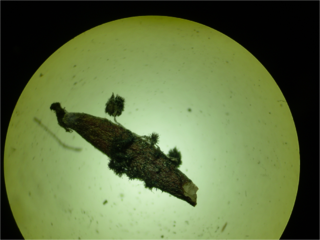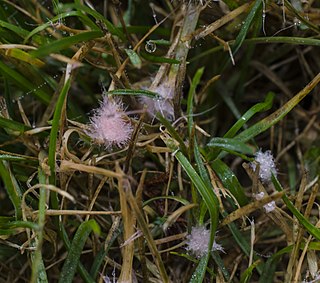
The fungal genus Pyrenophora includes 108 species, including the following plant pathogenic species: Pyrenophora teres, Pyrenophora graminea and Pyrenophora tritici-repentis.

The Mycosphaerellaceae are a family of sac fungi. They affect many common plants, such as eucalyptus, the myrtle family, and the Proteaceae. They have a widespread distribution.

Pleosporaceae is a family of sac fungi.

Microdochium is a genus of ascomycete fungi, which contains several plant pathogens. The teleomorph is Monographella. The genus was circumscribed by German mycologist Hans Sydow in 1924.

Bipolaris is a genus of fungi belonging to the family Pleosporaceae. It was circumscribed by mycologist Robert A. Shoemaker in 1959.
The Melanommataceae are a family of fungi in the order Pleosporales. Taxa are widespread in temperate and subtropical regions, and are saprobic on wood and bark.
The Phaeosphaeriaceae are a family of fungi in the order Pleosporales. Species in the family have a cosmopolitan distribution, and are generally nectrotrophic or saprobic on a wide range of plants.
Exarmidium is a genus of fungi in the family Hyponectriaceae.
Muyocopron is a genus of fungi in the Muyocopronaceae family.
Ascotaiwania is a genus of fungi in the Sordariomycetes class of the Ascomycota. In 2020, it was placed in the order Savoryellales and family of Savoryellaceae.

Seiridium is a genus of plant pathogens in the family Sporocadaceae.
Lasiodiplodia is a genus of fungi in the family Botryosphaeriaceae. There were about 21 species. Lasiodiplodia, commonly referred to as black-soot disease, is a significant pathogen in tropical forestry.

Cordana is an ascomycete fungus genus. In 2020, it was placed within the monotypic family of Cordanaceae, and within the order Coniochaetales.
Seimatosporium is a fungus genus within the family Sporocadaceae.
The Coniochaeta are a genus of pleomorphic yeasts of the order Coniochaetales and are pathogens of trees. Some species have also been found to form endophytic associations within plants in which they live inside plant tissues but do not actually harm the organism. They can take the form of pink to brown colonies, hyphae, conidiophores or sclerotia. In 2013, the Lecythophora were merged with the Coniochaeta, following suggestions by Ziauddin Khan et al.

Asperisporium is a genus of ascomycete fungi whose members are plant pathogens.

Rhinocladiella is a genus of fungi in the family Herpotrichiellaceae. It has 17 species. The genus was circumscribed by Swedish botanist John Axel Nannfeldt in 1934 with R. atrovirens as the type species.
Conioscypha is a genus of terrestrial and freshwater fungi in the monotypic family Conioscyphaceae and the monotypic order Conioscyphales. They are found on decayed wood, leaves, or bamboo stems. Except for Conioscypha japonica which was isolated from dog skin fragments and hair in 2017.








